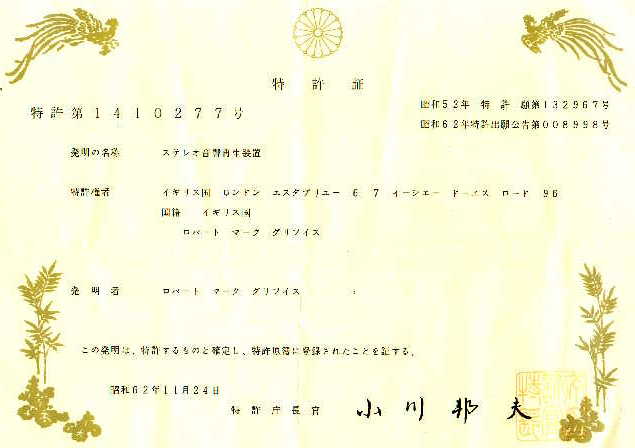Manfred's Stereo Man
Article first published in
"International Musician" in 1977.
Reprinted in "International Musician Legends" in 1988.
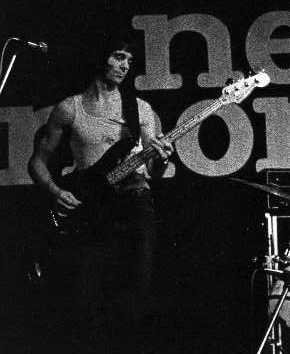 Mark Griffiths
Mark Griffiths
|
What does the term "stereo" mean to
you as a musician?
Do you instantly conjure up the feeling of two sources of
sound coming from your hi-fi speakers or does it mean the
bass sound of your guitar coming out of one amp while
another bright sound comes through a second amp.
Total stereo for guitars and keyboards now means more
than this basic split of two separate signals thanks to Mark
Griffiths, a musician who has invented an idea that is so
effective, yet so simple in principal, as to be ingenious.
The effect Mark has obtained is similar to that total
stereo image that is produced by the sound of a drum kit
when a drummer plays around the kit enabling the sounds of
one instrument (i.e. the kit) to be panned across from
speaker to speaker.
With his new wiring technique, Mark can turn a guitar
into a total stereo instrument with different strings coming
from different speakers at the same time. Mark, who
regularly plays bass for Claire Hammill's band,
"Transporter", produced an idea that caused Manfred Mann to
invest a considerable amount of money in patenting the idea.
Mark and Manfred are now hoping to interest manufacturers of
keyboards and guitars into installing the technique in
instruments when they are being built. In the following
article, Mark explains his concept.
|
Stereo Concept
'Stereo' instruments heve all fallen into a small amount
of catogories since theIr introduction.
To most mmicians who walk into their local music store to
buy a stereo guitar, they are generally confronted by an
instrument that has two p/ws, one close to the treble bridge
end and one close to the bass neck end of the guitar body.
These are wired through a standard mono tone and volume
circuit which can be split to a stereo socket. Thus these
two p/w can be connected to two separate amps in order to
obtain different tones either by way of the amp controls or
effects pedals. Gibson and Rickenbacker are two well known
makes which employ this method.
I think that Burns were the first manufacturers to
produce a guitar with a 'splitsound' p/u arrangement. This
method enables a guitarist to connect the bottom three
strings of the guitar to one amp and the top three strings
to a second amp giving the musician more scope than was
previously available to vary the tone and aural positioning
of the instrument. A few manutacturers are still marketing
this type of instrument and p/u.
On the keyboard side of things, there is the well
established Fender Rhodes Piano stereo panning device that
pans the whole sound of the piano from side to side, on a
stereo set up, at a rate that can be controlled by the
player. The Oberheim synthesizer features a logic device
which enables the player to prograrnme the instrument so
that a pre-set sequence of notes can be made to sound from
one side or the other of a stereo arrangement.
Finally, there are synths, organs, mellotrons etc. that
allow for one sound or effect to be produced through one
channel and a second different sound to be produced through
the second channel.
|
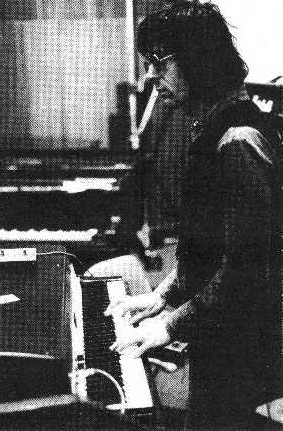 Manfred Mann with stereo converted Fender Rhodes
Manfred Mann with stereo converted Fender Rhodes
|
The invention that Manfred Mann and I have Patented stems
from my experiments with an English-made split-sound Shergold
Marathon bass. At the time I owned a Fender Precision, but whlie
wandering round the West End Music shops one day. I tried this
'split-sound' bass in Orange and immediately liked the feel and the
action of the woodwork of the guitar which was frankly 100% better
made than my 1975 Precision (which I stll own). The split-sound was
amazing for the funky music that I was playing at the time, so I
bought it there and then. The next time I played with the band, the
sound that was so beautiful in the shop, just fell flat in comparison
with the projection from my Fender (the downfall of all English p/us
seems to be lack of projection). This left me only one solution : -
to put the Precision p/us on the other bass. I made up a new
scratchplate, changed the tone control for a double/ ganged one (as
incredibly, with the Shergold design, there was no tone variation
available when one switched to stereo). This arrangement did the
trick and gave the bass good projection combined with a good fast
action.
At this stage I began wondering about the feasibility of making a
p/u that would produce a stereo 'picture' of the strings of the
guitar without resorting to complicated and expensive electronic
gadgetry.
I was very fortunate in achieving results at my first attempt.
This meant ripping the Fender p/w out of the Shergold and replacing
them with a pair of matching Vox bass p/w mouctod adjacently. I
angled the p/us in opposite directions, connected them to the
existing wiring and plugged the guitar hopefully into my stereo. Lo
and behold! There was the E string sounding from the LH speaker, the
A string Sounding from 1/3 of the distance betwean LH and RH
speaker., the D string sounding from 2/3 of the distance between RH
and LH speakers and the G string sounding from RH speaker. The magic
stereo picture! With the p/u in the bass position on the guitar body,
they were also sensitive to any bending of the strings on the higher
frets, thus giving me in effect, a control at my fingertips on the
instrument I was playing that could move the note I was playing
across the stereo image.
The next step to consult the well known instrument maker and
reparer Stephen Delft, who was impressed enough to give me some
invaluable advice on the potential of the innovation and ways of
patenting it.
In the time that has passed since then I heve developed and put
into practice some alternative ideas that heve stemmed from the
original concept. Manfred Mann is now using a Fender Rhodes piano
that produces consecutive pairs of notes from alternate sides of a
stereo set-up. Dave Flett of the Earthband can also be heard using a
Fender Strat that also produces consecutive strings from alternate
sides. This is particularly effective with lead guitar iines when
bending notes, the note being bent can start on the RH and end up
having moved across to the LH side of the stereo. (With ultra-light
strings some notes can start R, move to L and return to R again!) I
am using a Fender Precision in Claire HammiIl's band 'Transporter'
which incorporates 'aiternate string' stereo (Jazz Bass p/u), 'split
sound' stereo (Precision p/w) and Precision Mono.
I think that I should point out that the difference caused to the
controls of these instruments by converting them to stereo is
negligible:
The Fender Rhodes has an extra two-way mono/stereo switch mounted
alongside the existing controls.
The Fender Strat remains the same apart from the substitution of a
Gibson Humbucker (stereo) in the bass position.
The Fender Precision has an added three-way Strat-type swItch and
a pair of Fender Jazz bass p/us added in the bass position. The
volume and tone controis operate as standard.
All these instruments operate normally in mono with one amp.
It should be clear from this information that the added production
line cost to an existing manufacturer to produce these types of
stereo instruments is negligible. At present (as a custom conversion)
the approximate cost to convert an existing instrument is around
£60 for most instruments, and the process is completely
reversible should the buyer not be satisfied.
U.K. patent certificate
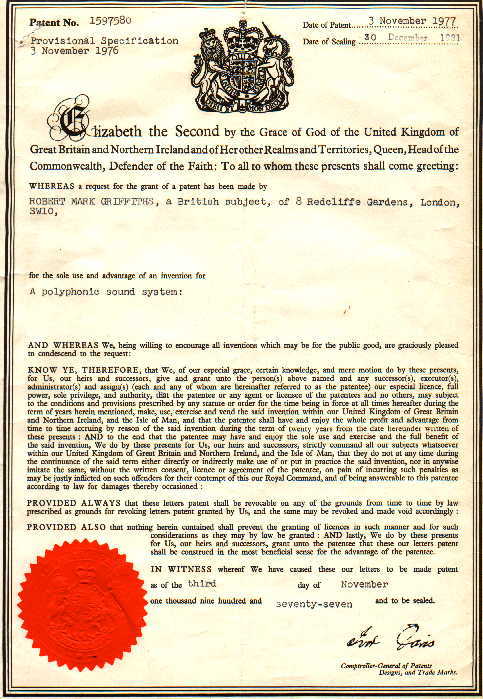
U.S. patent certificate
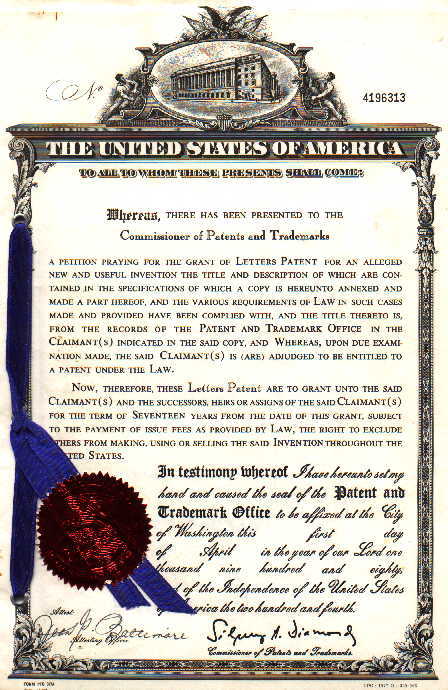
Japan patent certificate
